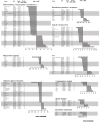Human decidual NK cells from gravid uteri and NK cells from cycling endometrium are distinct NK cell subsets
- PMID: 20172608
- PMCID: PMC2943934
- DOI: 10.1016/j.placenta.2010.01.003
Human decidual NK cells from gravid uteri and NK cells from cycling endometrium are distinct NK cell subsets
Abstract
Human NK cells from the decidua basalis of gravid uteri and from the cycling endometrium of women undergoing hysterectomy were isolated and compared by gene expression profiling using Affymetrix microarrays with probes representing approximately 47,400 transcripts. Substantial differences indicate that these two types of NK cells represent distinct subsets.
Copyright 2010 Elsevier Ltd. All rights reserved.
Figures



Similar articles
-
The effect of pregnancy on the uterine NK cell KIR repertoire.Eur J Immunol. 2011 Oct;41(10):3017-27. doi: 10.1002/eji.201141445. Epub 2011 Aug 30. Eur J Immunol. 2011. PMID: 21739430 Free PMC article.
-
The unique properties of uterine NK cells.Am J Reprod Immunol. 2010 Jun;63(6):434-44. doi: 10.1111/j.1600-0897.2009.00794.x. Epub 2010 Jan 4. Am J Reprod Immunol. 2010. PMID: 20055791 Review.
-
Understanding the heterogeneity of natural killer cells at the maternal-fetal interface: implications for pregnancy health and disease.Mol Hum Reprod. 2024 Nov 14;30(11):gaae040. doi: 10.1093/molehr/gaae040. Mol Hum Reprod. 2024. PMID: 39570646 Review.
-
[Expression and significance of chemokine CXC receptor 3, 4 and their ligands at the early pregnancy decidua and villi].Zhonghua Fu Chan Ke Za Zhi. 2008 Dec;43(12):904-8. Zhonghua Fu Chan Ke Za Zhi. 2008. PMID: 19134328 Chinese.
-
Human Innate Lymphoid Cells: Their Functional and Cellular Interactions in Decidua.Front Immunol. 2018 Aug 14;9:1897. doi: 10.3389/fimmu.2018.01897. eCollection 2018. Front Immunol. 2018. PMID: 30154799 Free PMC article. Review.
Cited by
-
The role of sex hormones in immune protection of the female reproductive tract.Nat Rev Immunol. 2015 Apr;15(4):217-30. doi: 10.1038/nri3819. Epub 2015 Mar 6. Nat Rev Immunol. 2015. PMID: 25743222 Free PMC article. Review.
-
Immunophenotype and cytokine profiles of rhesus monkey CD56bright and CD56dim decidual natural killer cells.Biol Reprod. 2012 Jan 16;86(1):1-10. doi: 10.1095/biolreprod.111.094383. Print 2012 Jan. Biol Reprod. 2012. PMID: 21900681 Free PMC article.
-
Ultrastructure alteration of decidual natural killer cells in women with unexplained recurrent miscarriage: a possible association with impaired decidual vascular remodelling.J Mol Histol. 2015 Feb;46(1):67-78. doi: 10.1007/s10735-014-9598-8. Epub 2014 Oct 30. J Mol Histol. 2015. PMID: 25355193
-
Emerging role for dysregulated decidualization in the genesis of preeclampsia.Placenta. 2017 Dec;60:119-129. doi: 10.1016/j.placenta.2017.06.005. Epub 2017 Jun 9. Placenta. 2017. PMID: 28693893 Free PMC article. Review.
-
Role of Natural Killer Cells during Pregnancy and Related Complications.Biomolecules. 2022 Jan 4;12(1):68. doi: 10.3390/biom12010068. Biomolecules. 2022. PMID: 35053216 Free PMC article. Review.
References
-
- Givan AL, White HD, Stern JE, Colby E, Gosselin EJ, Guyre PM, Wira CR. Flow cytometric analysis of leukocytes in the human female reproductive tract: comparison of fallopian tube, uterus, cervix, and vagina. Am J Reprod Immunol. 1997;38:350–359. - PubMed
-
- Eriksson M, Meadows SK, Wira CR, Sentman CL. Unique phenotype of human uterine NK cells and their regulation by endogenous TGF-{beta} J Leukoc Biol. 2004;76:667–675. - PubMed
-
- Loke YW, King A. Human Implantation: Cell Biology and Immunology. Cambridge: Cambridge University Press; 1995.
-
- King A, Jokhi PP, Burrows TD, Gardner L, Sharkey AM, Loke YW. Functions of human decidual NK cells. Am J Reprod Immunol. 1996;35:258–260. - PubMed
Publication types
MeSH terms
Grants and funding
LinkOut - more resources
Full Text Sources
Other Literature Sources
Molecular Biology Databases

